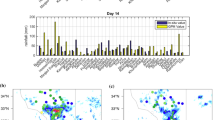Abstract
A mesoscale convective system (MCS) was generated over the South China Sea at around 115° E, 21°N on 0000 UTC 7 June 1998. Riding along the Mei-Yu front, the system moved through the Taiwan Strait and finally hit the southern part of the Taiwan Island, produced over 300 mm of rainfall over parts of Taiwan in the next 24 hours. It was found that the Penn State-NCAR Mesoscale Model Version 5 (MM5) did quite well in simulating the evolution of the MCS. Diagnostic studies on the mesoscale structure of MCS, moisture concentration process and the momentum budget were based on the model output. The concept model of the MCS in the mature phase can be concluded as the following: At the 850 hPa level, the mesoscale low level jet (mLLJ) was found to the southwest of the MCS, which was also associated with a mesoscale low generated by convection, the mesoscale upper level jet (mULJ) was found due east of the MCS (and an upper-level mesoscale high) at the 300 hPa level. Horizontal advection of momentum acted to accelerate the exit of the mLLJ but decelerate the entrance of the mLLJ where the pressure gradient force acted to compensate this lost and maintain its strength. For maintenance of the mULJ, vertical advection of momentum and the pressure gradient force were both found to be important.
Similar content being viewed by others
References
Tao, S. Y., Rainstorm in China (in Chinese), Beijing: Science Press, 1980, 94–121.
Ding, Y. H., Summer monsoon rainfalls in China, J. Meteor. Soc. Japan, 1992, 70: 337.
Du, J., Cho, H. R., Potential vorticity anomaly and mesoscale convective system on the Baiu (Mei-Yu) front, J. Meteor. Soc. Japan, 1996, 74: 891.
Li, Y. L., Tao, S. Y., Du, C. X., An analysis of the meso-convective cloud clusters in Mei-Yu front, Quart. J. Appl. Meteor. (in Chinese), 1993, 4: 278.
Ninomiya, K., Akiyama, T., Ikawa, M., Evolution and fine structure of a long-lived meso-α-scale convective system in a Baiu fronl zone. Part 1: Evolution and Meso-β-scale Characteristics, J. Meteor. Soc. Japan, 1988a, 66: 331–350.
Ninomiya, K., Akiyama, T., Ikawa, M., Evolution and fine structure of a long-lived meso-α-scale convective system in a Baiu front zone, Part II: Meso-y-scale characteristics of precipitation, J. Meteor. Soc. Japan, 1988b, 66: 351.
Chen, S. J., Kuo, Y. W., Wang, W. et al., A modeling case study of heavy rainstorms along the Mei-Yu Front, Mon. Wea. Rev., 1998, 126: 2330.
Ninomiya, K., Kuga, H., Yamagish, Y., Tatsumi, Y., Prediction experiment of extremely heavy rainstorm by fine mesh primitive equation model, J. Meteor. Soc. Japan, 1983, 62: 273.
Kato, T., Numerical simulation of the band-shaped torrential rain observed over southern Kyushu, Japan on 1 August 1993, J. Meteor. Soc. Japan, 1998, 76: 97.
Nagata, M., Ogura, Y., A modeling case study of interaction between heavy precipitation and a LLJ over Japan in the Baiu Season, Mon. Wea. Rev., 1991, 119: 1309.
Davison, N. E., Kurihara, K., Kato, T. et al., Dynamics and prediction of a mesoscale extreme rain event in the Baiu front over Kyushu, Japan. Mon. Wea. Rev., 1998, 126: 1608.
Zhang, D. L., Anthes, R. A., A high-resolution model of the planetary boundary layer-sensitive tests and comparisons with SESAME-79 data, J. Appl. Meteor., 1982, 21: 1594.
Dudhia, J., Numerical study of convection observed during the winter monsoon experiment using a mesoscale two-dimension model, J. Atmos. Sci., 1989, 46: 3077.
Grell, G. A., Dudhia. J., Stauffer, D. R., A description of the fifth generation Penn State/ NCAR mesoscale model (MM5), NCAR Tech. Note, NCAR/TN-398+STR, 1994: 138.
Reisner, J., Bruintjes, R. T., Explicit forecasting of super-cooled liquid water in winter storms using the MM5 mesoscale model, Quart. J. Roy. Meteor. Soc., 1998, 124B: 1071.
Reynolds, R. W., Smith, T. M., Improved global sea surface temperature analyses, J. Climate, 1994, 7: 929.
Johnson, R. H., Bartels, D. L., Circulation associated with a mature-to-decaying mid-latitude mesoscale convective system, Part II: Upper-level. Mon. Wea. Rev., 1992, 120: 1301.
Author information
Authors and Affiliations
About this article
Cite this article
Zhang, Q., Lau, KH., Wang, H. et al. Numerical simulation on mesoscale convective system along Mei-Yu front in Southern China. Chin.Sci.Bull. 45, 2093–2096 (2000). https://doi.org/10.1007/BF03183534
Received:
Issue Date:
DOI: https://doi.org/10.1007/BF03183534




